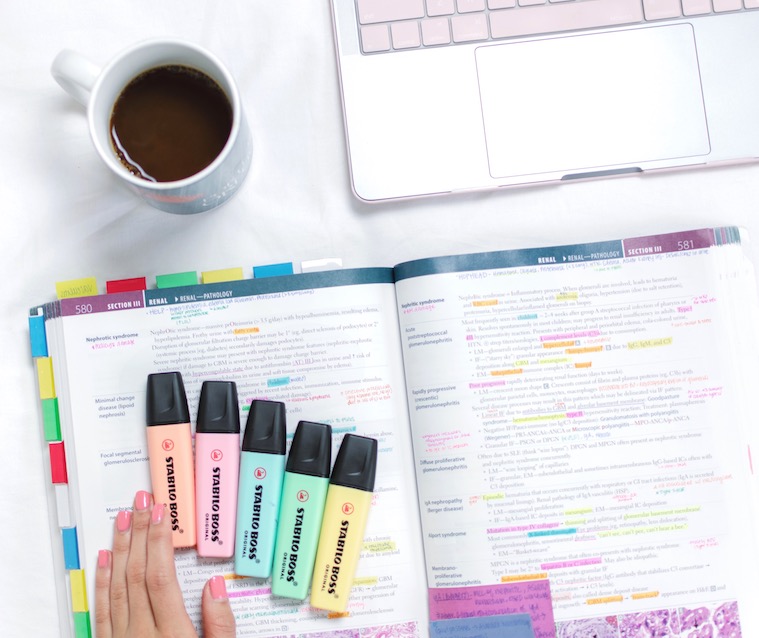
Hello and welcome to another USMLE Step 1 blog post! In this post, I’ll be discussing the various topics covered on my Step 1 exam, how I felt the resources I used prepared me for the exam. At the end, I’ll summarize which resources I thought best prepared me for the exam! Scroll to the bottom for the list of resources!
Note:
FA= First Aid for USMLE Step 1
UW= Uworld Question Bank
B&B= Boards and Beyond
Pathology
Pathology questions on my exam ranged from straightforward single-ordered questions requiring memorization to paragraph-long questions requiring multi-step reasoning and interpretation of lab values. 95% of what you need to know is covered in FA, Pathoma and UW. The other 5% are random questions that no one can really prepare for (just need to use your guessing skills here!). Beyond the previously mentioned resources, I supplemented with B&B for concepts I needed more thorough explanations for. During the school year, I completed practice questions with USMLE-Rx (see below for discount!) and I listened to Goljan lectures to prepare for my school exams. During dedicated, I used SketchyPath to help me memorize concepts requiring rote memorization (i.e. brain tumors, immunodeficiencies, renal tubular acidosis, vasculitities). All of these resources were great, but I highly recommend focusing on FA, Pathoma and UW!
Physiology
This was probably one of the more difficult topics on my exam. To do well, you need to have a solid understanding of cardiac, pulmonary, endocrine and renal physiology. You need to be able to reason through concepts in a step-wise manner (i.e. how a change in a patient’s volume status affects lymph flow, hydrostatic and interstitial pressure, kidney function, etc.) Beyond UW, I recommend using BRS Physiology and B&B.
Anatomy
These questions on the exam can be fairly straightforward if you know the material. I had plenty of first-ordered questions on MSK anatomy, hernias, cranial nerves, GI blood supply, lymph node drainage, layers of the scrotum, etc. Many of the complex questions I had required reading MRIs, X-rays, CT scans, ultrasounds, etc. So, don’t forget to review your imaging! I thought the material in FA covered about 75% of what was needed to know. I also reviewed this document which was somewhat helpful. Honestly, with these resources, I felt a little unprepared. I would have liked to use an additional resource, but I wasn’t aware of any great ones. (If you know of one, let me know so I can sure with my future mentees!)
Biochemistry
Many of the questions required a thorough understanding of the metabolic pathways. Be able to reason through pathways and know what products build up if an enzyme is deficient (it may not be your classic enzyme deficiencies). Memorize steps, enzymes, substrates and products of glycolysis and gluconeogenesis. Also, know your vitamins! I felt prepared for biochem thanks to Pixorize! It has visual mnemonics (think Sketchy) for the high-yield biochem content and is a phenomenal resource!! I highly recommend it (if this method of learning works for you)!
Microbiology
The microbiology questions on my exam were very straightforward. They were mostly first-ordered questions about virulence factors, virus structure, clinical disorders, etc. Sketchy and FA is more than enough.
Pharmacology
Many of the questions on my exam were first- to second-ordered questions. Again, focus on knowing Sketchy and FA and you’ll do well!
Behavioral Science
I was surprised by the number of questions I had on this topic! Most were straightforward, but there were a few where I was in between answers. Overall, I think B&B does a really great job covering what you need to know.
Biostatistics
I think my exam had an unusual representation of biostats as I had no calculation-based problems (odds ratio, relative risk, NNT/NNH…). Most of the questions on my exam were conceptual (i.e. study designs, biases, sensitivity/specificity changes based on cutoff values, interpretations of data, etc.). Either way, the best resource I found for biostatistics was Uworld Biostats. Buy it during dedicated. Review it 2-3 times and you’ll be set!
Overall, the best resources for USMLE Step 1 by subject are:
Pathology: UWorld, First Aid, and Pathoma. Supplement with Boards & Beyond. For extra questions, use USMLE-Rx! Add on Goljan lectures during the year if you have time and SketchyPath during dedicated for difficult to memorize pathologies.
Physiology: Boards & Beyond and BRS Physiology
Anatomy: First Aid
Biochem: Pixorize
Micro: SketchyMicro
Pharm: SketchyPharm
Behavioral Science: Boards & Beyond
Biostats: Uworld Biostats
Study essentials
Click here to get my exact USMLE Step 1 Study Schedule for only $5!

This post is so helpful thank you!
Hey Amanda,
Thank you for your feedback!! Good luck on your exam!
-Lily